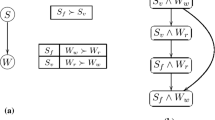Abstract
This paper deals with representation and solution of asymmetric decision problems. We describe a new graphical representation called sequential valuation networks, which is a hybrid of Covaliu and Oliver’s sequential decision diagrams and Shenoy’s asymmetric valuation networks. Sequential valuation networks inherit many of the strengths of sequential decision diagrams and asymmetric valuation networks while overcoming many of their shortcomings. We illustrate our technique by representing and solving a modified version of Covaliu and Oliver’s Reactor problem.
Access this chapter
Tax calculation will be finalised at checkout
Purchases are for personal use only
Preview
Unable to display preview. Download preview PDF.
Similar content being viewed by others
References
Bielza, C. and P. P. Shenoy (1999), “A comparison of graphical techniques for asymmetric decision problem?,” Management Science, 45(11), 1552–1569.
Call, H. J. and W. A. Miller (1990), “A comparison of approaches and implementations for automating decision analysis,” Reliability Engineering and System Safety, 30, 115–162.
Covaliu, Z. and R. M. Oliver (1995), “Representation and solution of decision problems using sequential decision diagrams,” Management Science, 41(12), 1860–1881.
Demirer, R. and P. P. Shenoy (2001), “Sequential Valuation Networks for Asymmetric Decision Problems,” Working Paper No. 286, University of Kansas School of Business, Lawrence, KS. Available by anonymous ftp from <ftp://ftp.bschool.ku.edu/home/pshenoy/wp286.pdf>
Fung, R. M. and R. D. Shachter (1990), “Contingent influence diagrams,” Working Paper Department of Engineering-Economic Systems, Stanford University, Stanford, CA.
Lauritzen, S. L. and D. J. Spiegelhalter (1988), “Local computations with probabilities on graphical structures and their application to expert systems” (with discussion), Journal of Royal Statistical society, Series B, 50(2), 157–224.
Liu, L. and P. P. Shenoy (1995), “A decomposition method for asymmetric decision problems,” in Proceedings of the 1995 Decision Sciences Institute Annual Meeting, 2, 589–591, Boston, MA.
Liu, L. and P. P. Shenoy (2000), “Representing asymmetric decision problems using coarse valuations,” Working Paper No. 287, University of Kansas School of Business, Summerfield Hall, Lawrence, KS.
Nielsen, T. D. and F. V. Jensen (2000), “Representing and solving asymmetric decision problems,” in C. Boutilier and M. Goldszmidt (eds), Uncertainty in Artificial Intelligence: Proceedings of the Sixteenth Conference, 416–425, Morgan Kaufmann, San Francisco, CA.
Qi, R., L. Zhang and D. Poole (1994), “Solving asymmetric decision problems with influence diagrams,” in R. L. Mantaras and D. Poole (eds.), Uncertainty in Artificial Intelligence: Proceedings of the Tenth Conference, 491–497, Morgan Kaufmann, San Francisco, CA.
Raiffa, H. (1968), Decision Analysis: Introductory Lectures on Choices under Uncertainty, Addison-Wesley, Reading, MA.
Shenoy, P. P. (1992), “Valuation-based systems for Bayesian decision analysis,” Operations Research, 40(3), 463–484.
Shenoy, P. P. (2000), “Valuation network representation and solution of asymmetric decision problems,” European Journal of Operational Research, 121(3), 2000, 579–608.
Smith, J. E., S. Holtzman and J. E. Matheson (1993), “Structuring conditional relationships in influence diagrams,” Operations Research, 41(2), 280–297.
Author information
Authors and Affiliations
Editor information
Editors and Affiliations
Rights and permissions
Copyright information
© 2001 Springer-Verlag Berlin Heidelberg
About this paper
Cite this paper
Demirer, R., Shenoy, P.P. (2001). Sequential Valuation Networks: A New Graphical Technique for Asymmetric Decision Problems. In: Benferhat, S., Besnard, P. (eds) Symbolic and Quantitative Approaches to Reasoning with Uncertainty. ECSQARU 2001. Lecture Notes in Computer Science(), vol 2143. Springer, Berlin, Heidelberg. https://doi.org/10.1007/3-540-44652-4_23
Download citation
DOI: https://doi.org/10.1007/3-540-44652-4_23
Published:
Publisher Name: Springer, Berlin, Heidelberg
Print ISBN: 978-3-540-42464-2
Online ISBN: 978-3-540-44652-1
eBook Packages: Springer Book Archive




